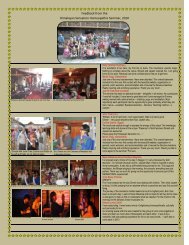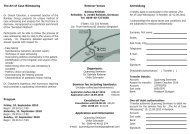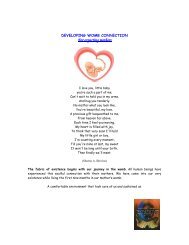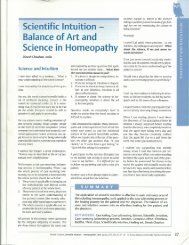Review About the book and author by Dr. Sameer Thakkar
Review About the book and author by Dr. Sameer Thakkar
Review About the book and author by Dr. Sameer Thakkar
You also want an ePaper? Increase the reach of your titles
YUMPU automatically turns print PDFs into web optimized ePapers that Google loves.
2<br />
witnessing is very important. To find <strong>the</strong> patient’s unique centre, we need to create a silent space, <strong>and</strong>, for<br />
that, we need to be passive. Dinesh’s emphasis in passive case witnessing, which is <strong>the</strong> first part, is to<br />
achieve <strong>the</strong> goal of individualisation. He puts stress on “being passive, while at <strong>the</strong> same time being alert”.<br />
Passive, so that our knowledge doesn’t come in between, <strong>and</strong> alert, so that you receive everything from <strong>the</strong><br />
patient without shifting his natural flow. Whatever is inside should come outside in <strong>the</strong> way that <strong>the</strong><br />
patient wants to tell you; <strong>the</strong>refore, whatever questions you pose should not alter this flow. In <strong>the</strong> passive<br />
phase, we have to take note of all <strong>the</strong> characteristic verbal <strong>and</strong> non-verbal expressions of <strong>the</strong> patient, as<br />
well as what <strong>the</strong> patient is knowingly or unknowingly keeping in <strong>the</strong> centre.<br />
We have to remain passive because, to begin with, a patient will more often than not express <strong>the</strong><br />
common, conscious human talk all jumbled up with a little non-human / nonsense talk. The non-human<br />
element initially comes at <strong>the</strong> spur of <strong>the</strong> moment; as <strong>the</strong> case advances, it becomes more <strong>and</strong> more<br />
intense. Finally, at <strong>the</strong> end, it comes to <strong>the</strong> forefront <strong>and</strong> draws everything closer toge<strong>the</strong>r.<br />
Staying alert <strong>and</strong> passive helps as this gives direction to a case.<br />
When we start to get active, we focus on <strong>the</strong> focus of <strong>the</strong> patient. Many homoeopaths ask this<br />
question: “Which word should I pick up once I have entered <strong>the</strong> active phase?” There are so many words<br />
that we can feel lost in <strong>the</strong> jungle. Dinesh suggests that we should scientifically pick up that which is in <strong>the</strong><br />
centre, which comes up again <strong>and</strong> again in two-to-three different areas not related to each o<strong>the</strong>r <strong>and</strong> in a<br />
different time zone. This is what Dinesh defines as <strong>the</strong> focus of <strong>the</strong> case. If a patient expresses something<br />
that is present in his chief complaint or dreams, <strong>and</strong> if he speaks about <strong>the</strong> same thing in relation to his<br />
childhood, it means this is <strong>the</strong> focus of <strong>the</strong> case.<br />
If a patient gets stuck halfway, you can ask open-ended, non-leading questions, so that <strong>the</strong> flow does<br />
not change. Dinesh maintains flexibility in applying <strong>the</strong> method. There are some cases where <strong>the</strong> patient’s<br />
level of experience is very low. For instance, whereever <strong>the</strong> pathology is high or <strong>the</strong> level of experience is<br />
low, in such cases, Dinesh suggests, we should become active from <strong>the</strong> beginning <strong>and</strong> scrutinise different<br />
subconscious areas (dreams, childhood, imagination, <strong>and</strong> incidents that have had a deep impact on <strong>the</strong><br />
patient). The aim here is to find <strong>the</strong> focus of <strong>the</strong> case in all <strong>the</strong>se areas, so that one is very sure of <strong>the</strong> focus<br />
<strong>and</strong> can become active with <strong>the</strong> focus.<br />
2) Active case witnessing:<br />
In this part of case taking, you ask questions leading in a particular direction (which <strong>the</strong> patient has,<br />
consciously or unconsciously, decided for us). Still, you remain open to where your patient will fur<strong>the</strong>r lead<br />
you. The questions that you select from <strong>the</strong> first part must activate <strong>the</strong> patient’s imagination. This inquiry,<br />
more often than not, will link <strong>and</strong> envelop <strong>the</strong> o<strong>the</strong>r irrelevant facets, too. During <strong>the</strong> process, we see what<br />
is known as “internal consistency.” If not, <strong>the</strong>n <strong>the</strong> physician will allow fur<strong>the</strong>r voluntary narration <strong>and</strong> only<br />
<strong>the</strong>n be at liberty to ask more precise questions, after picking up <strong>the</strong> vague / irrelevant aspects from <strong>the</strong><br />
new information. In this way, he must first completely underst<strong>and</strong> <strong>the</strong> subconscious aspect before going<br />
beyond it into <strong>the</strong> complete unconscious.<br />
Often, every aspect of <strong>the</strong> first part starts to unite everything. Ano<strong>the</strong>r way of putting it is that <strong>the</strong><br />
many gaps in <strong>the</strong> case get filled up <strong>and</strong> <strong>the</strong> complete pattern emerges at <strong>the</strong> subconscious level; <strong>the</strong>n, <strong>the</strong><br />
confluence point (<strong>the</strong> sensation pattern) will start appearing. You can say that you reached very close to <strong>the</strong><br />
global sensation.<br />
3) The Active-Active case witnessing process:







